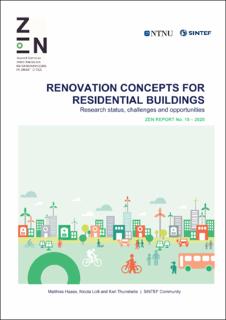| dc.contributor.author | Haase, Matthias | |
| dc.contributor.author | Lolli, Nicola | |
| dc.contributor.author | Thunshelle, Kari | |
| dc.date.accessioned | 2020-04-22T08:02:59Z | |
| dc.date.available | 2020-04-22T08:02:59Z | |
| dc.date.created | 2020-04-21T09:16:01Z | |
| dc.date.issued | 2020 | |
| dc.identifier.isbn | 978-82-536-1657-5 | |
| dc.identifier.uri | https://hdl.handle.net/11250/2651996 | |
| dc.description.abstract | This study looks at the challenges and opportunities in the deep energy renovation market with prefab elements. An analysis of 39 European projects was conducted, and the results where structured in three topics.
It clearly emerges from this analysis that finding the “composition” of the recipe of a successful deep renovation is a challenging task.
Technical barriers
(i) A lack of consistent and standardized solutions or integrated solutions to comply with new and different building standards requirements on energy saving
(ii) Lack of skilled workers to carry out the work
(iii) Shortcomings in technical solutions, and long processes discouraging owners
(iv) Safety/earthquake risk connected with the deep renovation processes (damages can be done to the homes while retrofitting or unsure perception of the current safety of the existing buildings)
(v) End users’ and owners’ lack of technical expertise and trust in effective energy renovation savings
Financial barriers
(i) high up-front costs and owners reluctant to borrow funds for energy renovation purposes
(ii) Long pay-back times of retrofitting interventions
(iii) Lack of confidence of the potential investors
(iv) Insufficient and instable available funding
(v) Lack of attractive financing for homeowners with low to medium incomes who are usually not eligible for regular bank loans
(vi) Existing financial tools are insufficient and unattractive Social barriers
(i) Decision-making processes that are long and complex, especially in cases of multi-owner houses (condominiums)
(ii) The lack of consensus, understanding, and support from the users that often hinder the effective approval of the interventions
(iii) The problem of disturbance during site works and/or relocation (in case owners/users need to leave their homes during the process)
(iv) Low awareness about energy efficiency and non-energy benefits of renovation
(v) Lack of dialogue between the different stakeholders
The resulting opportunities are discussed and provide information for various stakeholders in the deep energy renovation market with prefab elements.
1. Technologies
2. Renovation process
3. Financial mechanism and incentives
A clearer definition of the desired energy performance of a nearly Zero-Energy Building in the European legislation would support a more coherent approach by national governments. In consequence, this would trigger more innovation in the field and support a technology leadership of Europe in the field. | |
| dc.language.iso | eng | |
| dc.publisher | SINTEF akademisk forlag | |
| dc.relation.ispartofseries | ZEN Report;19 | |
| dc.subject | Deep energy renovation | |
| dc.subject | Energy renovation | |
| dc.subject | European projects prefab elements | |
| dc.title | Renovation concepts for residential buildings. Research status, challenges and opportunities | |
| dc.type | Research report | |
| dc.description.version | publishedVersion | |
| dc.subject.nsi | VDP::Teknologi: 500 | |
| dc.source.pagenumber | 68 | |
| dc.identifier.cristin | 1807247 | |
| dc.relation.project | Norges forskningsråd: 257660 | |
| cristin.ispublished | true | |
| cristin.fulltext | original | |
